A 14-member team from Mysuru was part of the Indian contingent to visit Shree Katas Raj Temple in Punjab province of the neighbouring nation.
By N.S. Sathyanarayana & A.G. Somashekar
Not many are blessed to visit the Hindu temple located across the border in Pakistan to celebrate the Mahashivarathri. Fourteen devotees from Mysuru visited Shree Katas Raj temple located in the Punjab province of Pakistan. Here is the story of their pilgrimage…
About the Temple
Shree Katas Raj is located at a distance of around 280 kms on the national highway from Lahore, the capital of Punjab Province to Rawalpindi (Islamabad).
According to the Evacuee Trust Property Board (ETPB), the Katas Raj templeswhich are attributed to the Hindu Shahiya community are dedicated to Lord Shiva and is an important Hindu Pilgrimage site present in Pakistan.
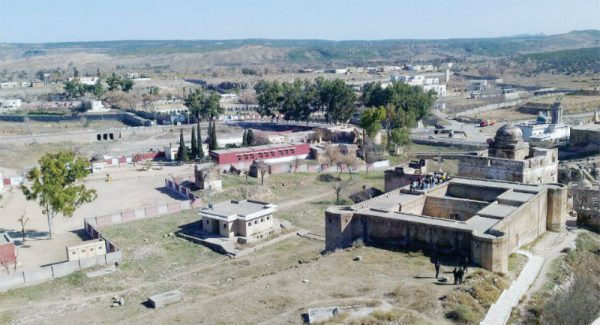
The Lord Shiv Temple complex where devotees from India stayed during the Mahashivarathri.
Temple Architecture
According to the devotees and pilgrims, the temple complex was constructed at a place which was once visited by the Pandava brothers of the Indian epic Mahabharata and is also considered the most significant Hindu temple site in the salt range.
Some of the main characteristics of this style of construction of temples are the den-tiles, trefoil arches, clouted pillars and pointed roofs. These temples were built with soft friable sand stone erected with plane masonry walls and cantoned plaster. After the decline of Buddhism in Gandhara and the adjoining regions, Hinduism revived once again under the Hindu Shahi dynasty. During the reign of the Hindu Shahis, numerous temples were built in now KPK Province and the Salt Range in Punjab, thus Katas Raj preserves an almost continuous record of temples.
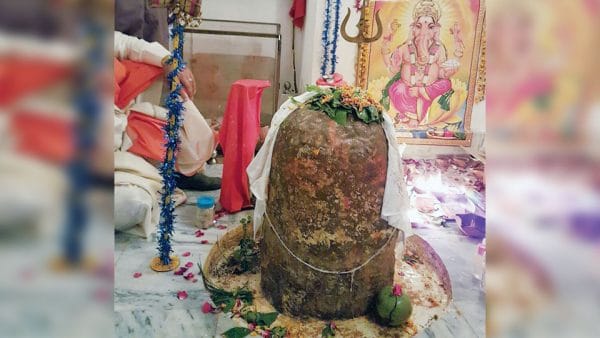
Shivalinga at Shree Katas Raj Temple
It is also said that the First Director General of Archeological Survey of India, Alexander Cunningham had visited this site in 1872-73 A.D and had confirmed the findings of Huen Tsang, a famous Chinese pilgrim of 7th Century, who had reported the stone Stupa of Asoka that was about 200 feet high and surrounded by 10 springs. Cunningham had also traced the walls of a gateway tower of the old fortification which lead down to the lower enclosure at the east end where stands the Sat Ghara. He accounted these temples as being the only ancient remains of any interest that existed in Katas, constructed a style similar to Kashmir temples of Karkota and Varma dynasties that ruled from 625 A.D. to 939 A.D.
There are many legends associated with Katas Raj and a lot of sanctity given to the building and natural heritage components. There is a Brahmanical story, which relates that Shiva was so inconsolable for the death of his wife Sati, the daughter of Dacha, that tears literally “rained from his eyes” and formed the two sacred pools of Pushkara or Pokhar, near Ajmer, and Kataksha or Katas. According to another mythical story, the site is believed to have been in Dvaitavana where Pandavas lived during the period of exile and the questioning session between the Pandavas and Yakshah had taken place at this site. The Sat-Ghara or “Seven Temples” are also believed to be a place where Pandavas lived during a portion of their 12 years exile. The pool has an irregular shape, measuring 150 feet in length with an extreme breadth of 90 feet at the upper end and about 50 feet at the lower end.
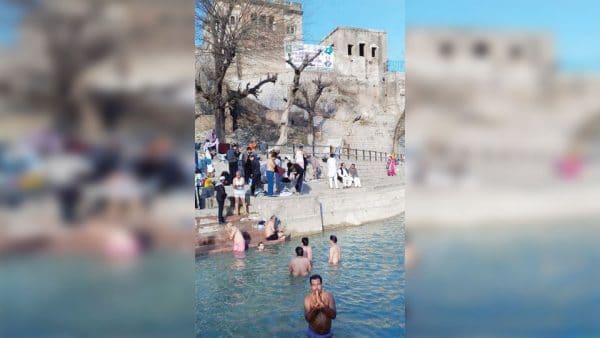
Devotees seen taking a holy dip at Katas Raj.
Our memories from the Yatra
Eighteen Mysureans were a part of this pilgrimage. Though we were supposed to travel during the month of November last year, we were not granted visa from Pakistan High Commission in India, New Delhi, due to security reasons as a result of which the trip got postponed. Our passports remained with Shri Bajaj. We started preparations for this journey again for the Mahashivarathri during February 2017. Out of 18, 14 people from Mysuru made it to the trip and a total of 237 Indians secured visa from Pakistan High Commission joined us. Apart from Karnataka, the pilgrims came from Delhi, Uttar Pradesh, Andhra Pradesh, Rajasthan, Haryana, Chattisgarh, Punjab, Jammu and Kashmir, Gujarat and other States.
It should be specially mentioned here, the number of pilgrims from Mysore City was the highest and combination of Mysore and Pak reminds us of famous sweet “Mysore – Pak”.
Arrangements were made for us to stay at the Dharmashala at Durgiana Mandir at Amritsar. We secured our passports from Shri Bajaj, the morning of 22nd February. We finished prayers at Durgiana Mandir. After getting some guidelines, we travelled to reach Attari – Wagha, the Border between India and Pakistan. It took a long time to go through formalities like the immigration, security, scanning and luggage checking, etc and we finally crossed the Wagha Border and entered Pak Border Gate and finished the necessary formalities there.

The plastic can having the picture of Pakistan PM Nawaz Sharif in which the holy water from Shree Katas Raj temple was brought.
The visa was issued to us specifically for 7 days from 22nd to 28th Feb. 2017 for Katas Yatra only. Our passports were taken away by the Pakistan Officials and Identity badges were issued to us. These badges were to be always displayed by us around our necks until our return to Pakistan Border. This is something special to Pakistan while in other countries passports are returned to us after the immigration formalities are completed. Later we were treated to sumptuous meal by the staff of Gurudwara in a mansion arranged by Pakistan authorities.
We started proceeding towards Lahore which was 30 Km only in sophisticated air conditioned buses and our accommodation was arranged in a centrally located Gurudwara at Lahore. On arrival at the Gurudwara we were extended warm welcome and many senior officials of Pakistan-Punjab province who received us personally very special.
On 23rd February 2017, we started our journey towards Katas Raj. The kind of security arranged was top class for proletarians like us. Two commandoes on motorbike, lead the security, followed by a gun man in a jeep and a military van, a fire engine and an ambulance. The same sequence of security followed our busses.

Seen in the picture are (from left) S.V. Prahlad, T.R. Nataraj, K.M. Gopamma, V.K. Annapoorna, Saraswathi, A.S. Ambika, A.G. Somashekar, A.S. Vittalaraju, N.S. Satyanarayana, S. Mangala and Chandru, the 11 among the 14 pilgrims from Mysuru, who visited Shree Katas Raj in Pakistan.
The roads in Lahore and the four-lane highway between Lahore and Rawalpindi were very good. We observed that all the roads were blocked except the one we were travelling to ensure there were no hindrances, giving us the feeling of high VVIPs. We covered the distance of 280 km from Lahore to Shree Katas Raj in three and a half hours. Our stay was arranged at a Mining School, around 400 metres away from Katas Raj Temple campus. We reached the Shiva temple complex and visited Amar Kund, sang devotional songs and bhajans and returned.
The next day was ‘Mahashivarathri’. We had carried with us honey, milk, dahi, ghee, grapes, cashews, almond, dates, etc, to perform abhishekha on Lord Shiva. Also, we carried Bilwa Patra leaves for the pooja. The next morning, we bathed in Amar Kund (Amrit Kund) and wore our traditional dresses and performed pooja. The Abhisheka on Lord Shiva was performed with all fervor and festivity. There were Mysoreans among us who could chant Vedas and mantras. The abhisheka ceremony and pooja were performed and we returned chanting vedic hymns as we walked past the roads. This was a life time experience since our vedas were supposed to have originated in the times of Mohanjadaro and Harappa time which is partly in Pakistan now.
There was a farewell programme for us in the evening. Mohammad Siddiqul Farooq, Chairman, Evacuee Trust Property Board (ETPB), Ministry of Religious Affairs and Inter – Faith Harmony, Government of Pakistan, invited us and there were prayers by Muslims followed by chanting of vedas and our traditional prayers. In his Presidential address, Siddiquul Farooq said that “religion and country are personal but humanity is universal. India and Pakistan are like brothers.”
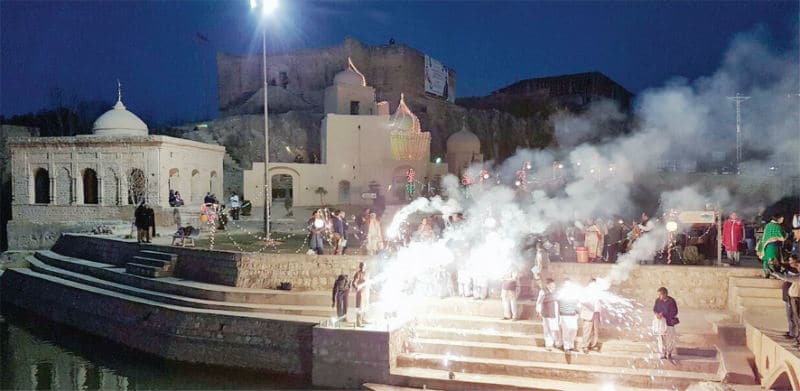
Devotees seen bursting fire crackers and sparklers
celebrating the ‘Night of Shiva’.
Later, we were asked to depart though we were scheduled to do so the next day, the reason for which was not told. We thus started are return journeyed in the night to reach Lahore early the next morning.
We also visited Lava’s Samadhi (Son of Lord Rama) and the Museum in the fort on 25th of February. The next day, we returned to Wagha Border with same kind of security arrangement and later reached Amritsar by afternoon. During the tour we were allowed to chants Veda Mantras and sing bhajans which was a memorable experience.
The Pilgrims from Mysuru were N.S. Sathyanarayana, S. Mangala, A.G. Somashekhar, Saraswathi, Dr. N. Satish, Dr. G. Veena, A.S. Vittalraju T.R. Nataraja, S.V. Prahllad, K.M. Gopamma, A.S. Ambika, V.K.B. Annapurna, R. Mahadeva and Mahadeva (Chandru), most of whom are YHAI members.
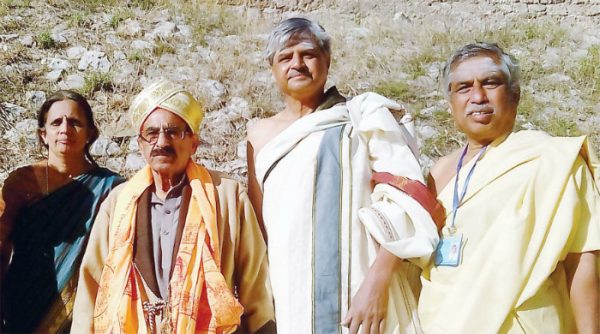
N.S. Sathyanarayana (second from right) seen with Shivapratap Bajaj,
President, Kendriya Sanatan Dharam Sabha (third from right). Also
seen are S. Mangala and A.S. Vittalaraju.
The weather
The weather during our visit was very chilly. We had to carry warm clothing but lodging facilities were provided Pakistani authorities, especially ETPB.
Requirements to undertake Shree Katas Raj Yatra
People willing to travel across the border to visit the temple need to have a visa to Pakistan. Interested ones should send their passport, two photographs, visa application form and also Rs.300 to Shivapratap Bajaj, President, Kendriya Sanatan Dharam Sabha (Northern India) and Chief Organiser of Sri Kattas Raj Thirtha Yatra. His official address: M-27, Industrial Area, Yamuna Nagar -135 001(Haryana). Mobile: 09315121595 and Telephone 01732-328452.
This pilgrimage of ours was not expensive as it cost us about Rs.8,000 to Rs.9,000 per person with travel arrangement by train in II Class sleeper coach from Mysuru to New Delhi – Amritsar and Wagha Border and back. All accommodation, transport and other expenses was borne by Pakistan Government as we followed the procedures as told by Shivpratap Bajaj.
FAQs
What would be the expenditure of the tour?
It is unbelievable that this pilgrimage of ours cost us only Rs.8,000 to Rs.9,000 per person with travel arrangement by train in II Class sleeper coach from Mysore to New Delhi – Amritsar and Wagha Border and back. All accommodation, transport and other living expenses will be borne by Pakistan Government when we follow the above procedure through Shri Shivpratap Bajaj.
What is the amount of money for foreign exchange?
Not required. People in Pakistan accept Indian currency when we purchase materials for Rs.500 and above.
Which are the other tourist places in Shree Katas Raj, apart from Lord Shiva Temple?
There is a huge campus in which relics of Sri Rama Temple, Hanuman Mandir, Sankskrit College, Buddhist temple, etc. are located.



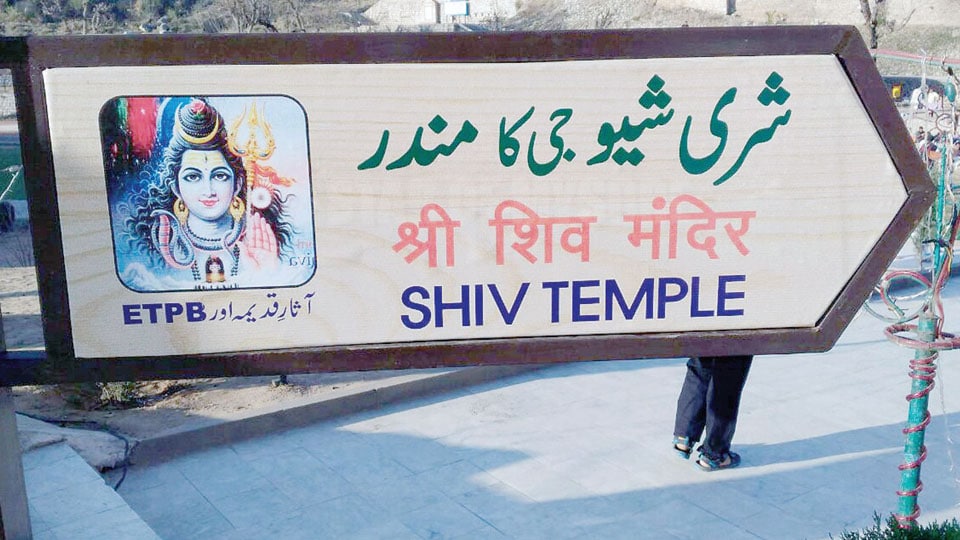




Bold and adventours piligrims.! Congragulations